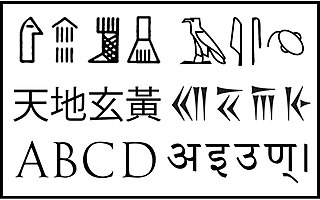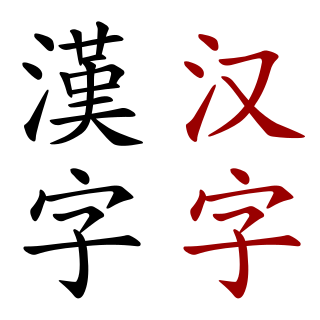Related Research Articles

An alphabet is a standard set of letters written to represent particular sounds in a spoken language. Specifically, letters correspond to phonemes, the categories of sounds that can distinguish one word from another in a given language. Not all writing systems represent language in this way: a syllabary assigns symbols to spoken syllables, while logographies assign symbols to words, morphemes, or other semantic units.
An abjad, also abgad, is a writing system in which only consonants are represented, leaving the vowel sounds to be inferred by the reader. This contrasts with alphabets, which provide graphemes for both consonants and vowels. The term was introduced in 1990 by Peter T. Daniels. Other terms for the same concept include partial phonemic script, segmentally linear defective phonographic script, consonantary, consonant writing, and consonantal alphabet.

An abugida – sometimes also called alphasyllabary, neosyllabary, or pseudo-alphabet – is a segmental writing system in which consonant–vowel sequences are written as units; each unit is based on a consonant letter, and vowel notation is secondary, similar to a diacritical mark. This contrasts with a full alphabet, in which vowels have status equal to consonants, and with an abjad, in which vowel marking is absent, partial, or optional – in less formal contexts, all three types of the script may be termed "alphabets". The terms also contrast them with a syllabary, in which a single symbol denotes the combination of one consonant and one vowel.

The Latin alphabet, also known as the Roman alphabet, is the collection of letters originally used by the ancient Romans to write the Latin language. Largely unaltered with the exception of additions and extensions, it forms the Latin script that is used to write many modern European languages, including English and many modern Asian languages, including Malay, Indonesian and Modern Standard Syloti (MSS). With modifications, it is also used for other alphabets, such as the Vietnamese alphabet. Its modern repertoire is standardised as the ISO basic Latin alphabet.

Various Mongolian writing systems have been devised for the Mongolian language over the centuries, and from a variety of scripts. The oldest and native script, called simply the Mongolian script, has been the predominant script during most of Mongolian history, and is still in active use today in the Inner Mongolia region of China and has de facto use in Mongolia.

Penmanship is the technique of writing with the hand using a writing instrument. Today, this is most commonly done with a pen, or pencil, but throughout history has included many different implements. The various generic and formal historical styles of writing are called "hands" while an individual's style of penmanship is referred to as "handwriting".

Shorthand is an abbreviated symbolic writing method that increases speed and brevity of writing as compared to longhand, a more common method of writing a language. The process of writing in shorthand is called stenography, from the Greek stenos (narrow) and graphein. It has also been called brachygraphy, from Greek brachys (short), and tachygraphy, from Greek tachys, depending on whether compression or speed of writing is the goal.

Cuneiform is a logo-syllabic writing system that was used to write several languages of the Ancient Near East. The script was in active use from the early Bronze Age until the beginning of the Common Era. Cuneiform scripts are marked by and named for the characteristic wedge-shaped impressions which form their signs. Cuneiform is the earliest known writing system and was originally developed to write the Sumerian language of southern Mesopotamia.
A constructed writing system or a neography is a writing system specifically created by an individual or group, rather than having evolved as part of a language or culture like a natural script. Some are designed for use with constructed languages, although several of them are used in linguistic experimentation or for other more practical ends in existing languages. Prominent examples of constructed scripts include Korean Hangul and Tengwar.
Uchen is the upright, block style of the Tibetan script. The name means "with a head", and is the style of the script used for printing and for formal manuscripts.

Canadian syllabic writing, or simply syllabics, is a family of writing systems used in a number of Indigenous Canadian languages of the Algonquian, Inuit, and (formerly) Athabaskan language families. These languages had no formal writing system previously. They are valued for their distinctiveness from the Latin script and for the ease with which literacy can be achieved. For instance, by the late 19th century the Cree had achieved what may have been one of the highest rates of literacy in the world.

The Phagspa script or ʼPhags-pa script is an alphabet designed by the Tibetan monk and State Preceptor Drogön Chögyal Phagpa (1235-1280) for Kublai Khan, the founder of the Yuan dynasty (1271-1368) in China, as a unified script for the written languages within the Yuan. The actual use of this script was limited to about a hundred years during the Mongol-led Yuan dynasty, and it fell out of use with the advent of the Ming dynasty.

The history of the Greek alphabet starts with the adoption of Phoenician letter forms in the 9th–8th centuries BC during early Archaic Greece and continues to the present day. The Greek alphabet was developed during the Iron Age, centuries after the loss of Linear B, the syllabic script that was used for writing Mycenaean Greek until the Late Bronze Age collapse and Greek Dark Age. This article concentrates on the development of the alphabet before the modern codification of the standard Greek alphabet.

The history of writing traces the development of writing systems and how their use transformed and was transformed by different societies. The use of writing prefigures various social and psychological consequences associated with literacy and literary culture.
In a featural writing system, the shapes of the symbols are not arbitrary but encode phonological features of the phonemes that they represent. The term featural was introduced by Geoffrey Sampson to describe the Korean alphabet and Pitman shorthand.

The writing systems of Africa refer to the current and historical practice of writing systems on the African continent, both indigenous and those introduced. In Sub-Saharan African societies, history generally used to be recorded orally despite most societies having developed a writing script, leading to them being termed "oral civilisations" in contrast to "literate civilisations".

The Mende Kikakui script is a syllabary used for writing the Mende language of Sierra Leone.

The Chinese family of scripts includes writing systems used to write various East Asian languages, that ultimately descend from the oracle bone script invented in the Yellow River valley during the Shang dynasty. These include written Chinese itself, as well as adaptations of it for other languages, such as Japanese kanji, Korean hanja, Vietnamese chữ Hán and chữ Nôm, Zhuang sawndip, and Bai bowen. More divergent are the Tangut script, Khitan large script, Khitan small script and its offspring, the Jurchen script, as well as the Yi script, Sui script, and Geba syllabary, which were inspired by written Chinese but not descended directly from it. While written Chinese and many of its descendant scripts are logographic, others are phonetic, including the kana, Nüshu, and Lisu syllabaries, as well as the bopomofo semi-syllabary.

A writing system comprises a particular set of symbols, called a script, as well as the rules by which the script represents a particular language. Writing systems can generally be classified according to how symbols function according to these rules, with the most common types being alphabets, syllabaries, and logographies. Alphabets use symbols called letters that correspond to spoken phonemes. Abjads generally only have letters for consonants, while pure alphabets have letters for both consonants and vowels. Abugidas use characters that correspond to consonant–vowel pairs. Syllabaries use symbols called syllabograms to represent syllables or moras. Logographies use characters that represent semantic units, such as words or morphemes.
References
- ↑ John Malalas, Chronographia, book I, section 1 (translation by Elizabeth Jeffreys, Michael Jeffreys, Roger Scott et al. 1986, page 2)